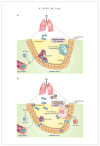Immune dysfunction and bacterial coinfections following influenza
- PMID: 23964104
- PMCID: PMC3760235
- DOI: 10.4049/jimmunol.1301152
Immune dysfunction and bacterial coinfections following influenza
Abstract
Secondary pulmonary infections by encapsulated bacteria including Streptococcus pneumoniae and Staphylococcus aureus following influenza represent a common and challenging clinical problem. The reasons for this polymicrobial synergy are still not completely understood, hampering development of effective prophylactic and therapeutic interventions. Although it has been commonly thought that viral-induced epithelial cell damage allows bacterial invasiveness, recent studies by several groups have now implicated dysfunctional innate immune defenses following influenza as the primary culprit for enhanced susceptibility to secondary bacterial infections. Understanding the immunological imbalances that are responsible for virus/bacteria synergy will ultimately allow the design of effective, broad-spectrum therapeutic approaches for prevention of enhanced susceptibility to these pathogens.
Figures


References
-
- MacCallum WG. Pathological anatomy of pneumonia associated with influenza. Johns Hopkins Hosp Rep. 1921;20:149.
-
- Opie EL, Blake FG, Rivers TM. The pathology and bacteriology of pneumonia following influenza. In: Opie EL, Blake FG, Small JC, Rivers TM, editors. Epidemic Respiratory Disease. The Pneumonias and Other Infections of the Respiratory Tract Accompanying Influenza and Measles. C.V. Mosby; St. Louis: 1921. pp. 107–281.
-
- Sun K, Metzger DW. Inhibition of pulmonary antibacterial defense by interferon-γ during recovery from influenza infection. Nat Med. 2008;14:558–564. - PubMed
Publication types
MeSH terms
Grants and funding
LinkOut - more resources
Full Text Sources
Other Literature Sources
Medical

